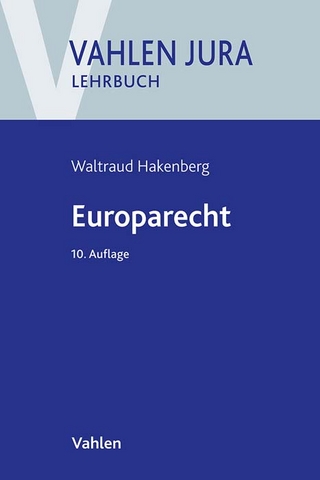
EU Law and International Arbitration
Hart Publishing (Verlag)
978-1-5099-3117-0 (ISBN)
George A Berman, Columbia Law School, European Law Review
This timely book addresses the main areas of tension between EU law and international arbitration, looking at both commercial and investment treaty arbitration. It opens pathways for practical solutions based on communication between the different regimes. At the same time, it offers a sound theoretical basis that allows for addressing the core problem as normative conflict between legitimate public interests and the ‘privatisation of justice’.
The book is divided into five parts. It introduces key aspects of the overall tension between EU law and international arbitration, before setting out the theoretical framework that understands EU law, international commercial arbitration, and investment treaty arbitration as closed regimes. The author then addresses the core problem of finding the limits to contracting out of the EU legal regime, both on a jurisdictional and a substantive level. This is then linked to the question of trust-building in legal outcomes of the relevant regimes. The book concludes with a short summary and key theses.
Combining a theoretical and normative with a more pragmatic approach to very topical issues, this book offers invaluable insights for academics and practitioners, private and public, commercial and investment treaty lawyers alike.
Konstanze von Papp is Professor of Public and European Union Law at Hamburg University of Applied Sciences.
1. Introduction
I. The EU and International Arbitration in the International Legal System
A. The EU as Supranational Entity
B. International Arbitration as Part of International Law
II. Restrictions on International Arbitration by the EU’s Judicial System
A. The Role of the Court of Justice of the EU
B. ‘Party Autonomy’ Challenged by EU Judicial Supremacy
III. The Public/Private Divide
A. Distinguishing Treaty-Based from Commercial Arbitration
B. Contractual and Jurisdictional Theories of Arbitration
IV. Privatisation of Justice within the EU?
A. EU Law as Transnational Law
B. The Doctrine of Non-Arbitrability in International Commercial Arbitration
C. The Legitimacy Debate in Investment Treaty Arbitration
D. Developing an EU Arbitral Model through Dialogue
2. The Nature of EU Law and International Arbitration
Introduction
I. Theoretical Framework
A. The Contribution of Regime Theory
B. Core Insights from Systems Theory
(i) The Legal System as a Functional Sub-System of the Social System
(ii) The Autonomous Self-Reproduction of the Legal System
(iii) Structural Coupling between the (Legal) System and its Environment
(iv) Reducing Social Complexity through Trust
C. The Primacy and Autonomy of EU Law Revisited
(i) Self-Referential Nature of the EU
(ii) Structural Coupling between EU and General International Law?
D. Arbitration Agreements as Self-Validating Contracts?
(i) The Self-Referential Nature of ICA and ITA
(ii) Enforcing the Agreement to Arbitrate: Article II of the New York Convention
(iii) Enforcing the Agreement to Arbitrate in Investment Treaty Arbitration (ITA)
II. Arbitrability from a Transnational Law Perspective
A. Contracting Out of the Law: Normative Considerations
(i) A Contractual Perspective: Protecting the Weaker Party through Non-Derogable Rules
(ii) A Public Interest Perspective: Protecting a Specific Public Good
B. Limits to Arbitrability: Contracting Out of a Legal Regime?
(i) The Doctrine of Non-Arbitrability and its Decline: Mitsubishi Motors and CDC Hydrogen Peroxide
(ii) Protecting the Public Policy of the Forum
3. Contracting Out of the EU’s Legal Regime
I. EU Law and International Commercial Arbitration
A. The Brussels (Recast) Regulation and its Arbitration Exception: A Contractual Paradigm?
(i) The Brussels Regulation as Regulatory Instrument?
(ii) The Arbitration Exception before and after West Tankers
(iii) Gazprom: Cutting off Arbitration Tribunals from the EU Legal System
B. The Reach of EU Public Policy: What is Left of Party Autonomy?
(i) Consumer Protection as EU Public Policy
(ii) Practical Implications for the Enforcement Court
(iii) A Regulated Pro-Arbitration Approach?
II. EU Law and Investment Treaty Arbitration
A. EU Autonomy and Mutual Trust as Pillars for EU Self-Preservation
(i) EU Regulation of State Contracting
(ii) Strict Obligation for EU Members to use the EU Judicial System under Achmea
(iii) Critique
B. The Reach of Article 344 TFEU: An Overarching EU Law Paradigm for Non-Arbitrability?
(i) Distinguishing EU Law-Related Disputes from Cases Involving EU Law as Fact
(ii) Can the CETA-Opinion be Reconciled with Achmea?
(iii) Critique
4. Building Trust in Legal Outcomes of EU Law and International Arbitration
I. The Challenges
A. The Problem of Legitimacy in a Transnational Context
(i) What is Legitimacy?
(ii) The Legitimacy Debate in EU Law
(iii) The Legitimacy Debate in ITA
(iv) Repercussions for ICA
B. Fundamental Risk for the International Legal System
(i) Democracy as a Benchmark?
(ii) Risk of Re-Politisation and Re-Nationalisation
(iii) Implications for Reform Suggestions
(iv) Squaring the Law, the Market, and Democracy: The Example of EU Fundamental Freedoms
II. Ensuring Critical Self-Reflection through Outward Engagement
A. Institutionalised Dialogue
(i) Improving the Indirect Link between the CJEU and Arbitral Tribunals via Member State Courts
(ii) Building a Direct Link between the CJEU and Arbitral Tribunals
(iii) CJEU Capacity?
B. Building Structure through Common Concepts
(i) Baseline and Core Legal Concepts
(ii) Looking Beyond the Law
5. Summary and Key Theses
Chapter One
Chapter Two
Chapter Three
Chapter Four
Overall Conclusion
| Erscheinungsdatum | 07.05.2021 |
|---|---|
| Verlagsort | Oxford |
| Sprache | englisch |
| Maße | 156 x 234 mm |
| Gewicht | 413 g |
| Themenwelt | Recht / Steuern ► EU / Internationales Recht |
| ISBN-10 | 1-5099-3117-1 / 1509931171 |
| ISBN-13 | 978-1-5099-3117-0 / 9781509931170 |
| Zustand | Neuware |
| Informationen gemäß Produktsicherheitsverordnung (GPSR) | |
| Haben Sie eine Frage zum Produkt? |
aus dem Bereich


